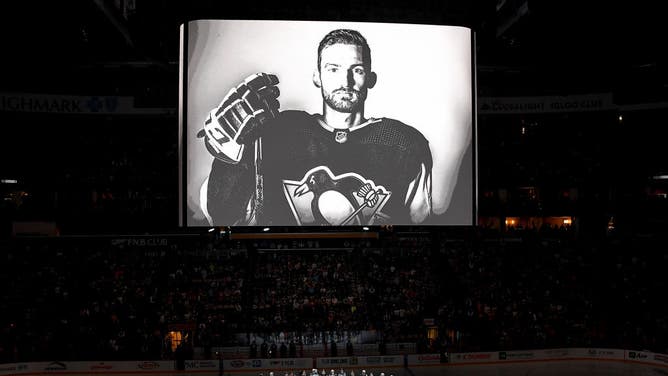Hockey Governing Body In England Rolling Out Neck Guard Mandate After Adam Johnson's Death: A Smart Idea Or A Knee-Jerk Reaction To A Tragic Situation
The English Ice Hockey Association (EIHA) — the sports governing body in England and Wales — has announced plans to mandate neck guards for players at every level starting in 2024. This comes following the death of former NHL player Adam Johnson during a game over the weekend.
However, such a sweeping mandate on short notice begs the question of whether or not it's a good idea — one thought through logically — or a knee-jerk reaction to an unimaginable tragedy.
Johnson was playing for the Nottingham Panthers of the Elite Ice Hockey League over the weekend when he received a catastrophic neck laceration from the skate blade of Sheffield Steelers player Matt Petgrave.
"Undoubtedly, this moment in time casts a sombre shadow upon our global sporting community, serving as a stark reminder of our collective responsibilities as custodians of the sport," a statement from the EIHA said. "As in all sports, the safety of our players must take precedence above all else. We are firmly committed to our obligation to exhaust every possible means to ensure that a tragic incident of this nature never befalls our sport again."
Neck Guard Mandate Is Part Of Three-Pronged Safety Initiative
According to ESPN, the EIHA announced this week that it is recommending the neck guard for players at all levels. This recommendation will become a mandate when the calendar flips over to 2024. This is part of a three-point initiative to improve safety in hockey.
Immediately after this incident, I was curious about what leagues, governing bodies, and individual players might do when it comes to wearing neck guards. That's because while this was one of the most severe neck lacerations to happen at the professional level it's not the first.
Buffalo Sabres goalie Clint Malarchuk sustained a similar injury in 1989, as did Florida Panthers player Richard Zednik in 2008. Fortunately, both survived, but those instances opened conversations about the need for neck guards.
Obviously, despite the conversations from those and other incidents, neckguards still aren't all that common at any level of hockey, let alone at the professional level.
Still, such startling news will make every player consider the idea of wearing one. Surely, some EIHL players will wear them, and some members of the Providence Bruins — the AHL affiliate of the Boston Bruins — were already seen wearing them.
Additionally, Yahoo Sports reported that the NHL is recommending that players wear them as well.
Players should wear whatever safety equipment makes them feel comfortable on the ice
Better to be safe than sorry, right?
Well, sort of...
Neck Laceration Protectors Are Far From Bulletproof In Preventing Injury, But They Can Still Help
The unfortunate reality appears to be that putting on a neck guard may not completely minimize the chance of suffering an injury. A USA Hockey study found that 27% of players who suffered a neck laceration were wearing some form of neck laceration protector.
That's a startling figure when you consider how few players tend to wear them in the first place.
So while it appears the threat of injury can't be eliminated, it's important to note that the majority of these neck lacerations caused only superficial damage. That same USA hockey study found that 61% of the incidents looked at only required bandaging.
However, while they're not bulletproof, it is important to note that USA Hockey still recommends that players wear neck guards.

Is This Mandate Necessary?
Considering the fact that removing the threat of injury is virtually impossible, does it make sense to mandate a piece of equipment that may not work?
I would say no, but if it were me playing, even the prospect of a moderate decrease in injury risk would make me throw one on.
As a hockey-playing kid in Central Pennsylvania in the late aughts, I recall wearing a neck guard in the aftermath of the Richard Zednik incident. However, I eventually stopped wearing it and played the last few years of high school hockey without one.
Could this be the case today? Following such a tragic, traumatic incident, will there be an influx of players wearing neck guards, only for that number to decrease as time goes on? I think that's exactly what will go on.
Personally, I think that the EIHA is making a bit of a knee-jerk reaction with its mandate, but honestly, can you blame them? They needed to take some action following this incident, and they decided that this was it.
Is it the right call? That's up for debate, but it's good to see that player safety is front of mind for the EIHA.
As it should be.
Follow on X: @Matt_Reigle